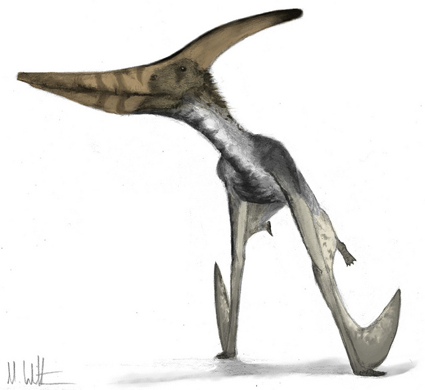Paleontologist Michael Habib studies the biomechanics of pterosaurs, the biggest of which—at 550 pounds and with a 34-foot wingspan—were the size of modern-day fighter jets. They were the largest flying animals ever to exist and sported anatomy different from any bird or bat. This makes them a unique model for flight mechanics, particularly for large aircraft.
To model how pterosaurs flew, Habib combines principles of physics and vertebrate anatomy with fossil data. He hopes that this knowledge will suggest new aircraft designs and other technology to places like nasa and the dod—it already has in some cases. In an abstract sense, he has brought these animals back from the dead. Pterosaur-inspired applications follow.
Flying Robots over Mars
Traditional spacecraft would need to fly extremely fast to stay aloft in Mars’s thin atmosphere, an impracticality if scientists want to survey Martian terrain in detail. One solution may be a robot that flies like a pterosaur—with swift beating wings and a relatively slow-moving body. Hummingbirds and bumblebees also fly this way, and NASA has created designs for robots based on the biomechanics of these “flapping fliers.”
Morphing Wings
In each wing, pterosaurs had a single tapered finger that grew up to 2.5 meters long in the largest species. When pterosaurs flew, those fingers bent with the force of the downward wing stroke and then reflexively snapped back into position on the upward stroke. The spontaneous return to equilibrium saved pterosaurs significant energy when flapping. Habib says roboticists in the U.S. Air Force are interested in morphing wings, which they could use in flight systems in aircraft or in parachutes—essentially highly convex wings.
Rapid-Launch Systems
Unlike planes today, giant pterosaurs did not need runways. They were experts at vertical takeoff, a feat that is impossible or incredibly inefficient for today’s aircraft. Because the reptiles had stiff but lightweight, hollow bones, they could use all four limbs—both their feet and wings—to push powerfully against the ground. That action allowed them to generate more speed over a shorter distance as they leaped into flight. Habib is currently negotiating a Defense Advanced Research Projects Agency grant proposal with the DOD to design an aircraft system with analogous physical characteristics and a quadrupedal launch strategy that would allow pilots to perform a quick vertical launch or takeoff on low fuel.
Low-Flutter Tents
To fly, pterosaurs kept their wings uniformly taut. Those wings were membranous, with long, thick fibers crisscrossed by smaller fibers that controlled how much the wings fluttered. The fibers individually moved under high air pressure, but their varied dimensions meant they oscillated at opposing frequencies that ultimately canceled out, enabling pterosaurs to maintain a steady wing. Habib has approached manufacturers with a tent fabric design that exploits the same physical principle to reduce noisy flapping and improve stability in high wind conditions.






